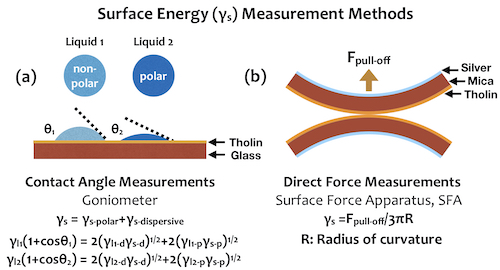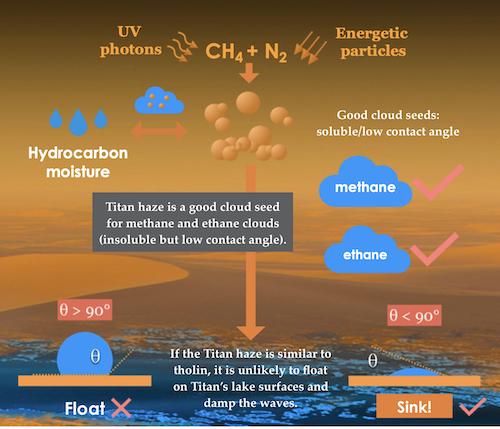Surface energy of the Titan aerosol analog "tholin": implications on cloud formation and aerosol-lake interactions
- 1University of California Santa Cruz, Department of Earth and Planetary Sciences, Santa Cruz, California 95064, USA (xintingyu@ucsc.edu)
- 2Johns Hopkins University, Department of Earth and Planetary Sciences, Baltimore, Maryland 21218, USA
- 3Johns Hopkins University, Department of Materials Science and Engineering, Baltimore, Maryland 21218, USA
- 4University of California Santa Barbara, Department of Chemical Engineering, Santa Barbara, California 93106, USA
- 5University of California Santa Cruz, Department of Astronomy and Astrophysics, Santa Cruz, California 95064, USA
The photochemical haze produced in the atmosphere of Titan plays a key role in various processes happening on Titan (Hörst, 2017). One of the physical properties of the haze, the surface energy, is crucial for understanding the growth of the solid haze particles and can be used to predict their interactions with solid and liquid species in Titan’s atmosphere and lakes. However, the surface energy of Titan’s haze is not well understood. We produced Titan analog haze materials, so-called "tholin", with different energy sources and measured their surface energies through contact angle and direct force measurements (Yu X. et al., 2020, in revision). From the contact angle measurement, we found that the tholins produced by cold plasma and UV irradiation have similar total surface energy. The commonly used two-liquid component method yields a total surface energy of tholin of ∼65–70 mJ/m. The direct force measurement yields a total surface energy of ∼66 mJ/m2 for plasma tholin.

The surface energy of tholin is relatively high compared to common polymers, indicating its high cohesiveness. Thus the Titan haze particles are likely to coagulate easily to form bigger particles, while the surface sand could be hard to be mobilized by the wind because of the high interparticle cohesion. The high surface energy of tholins also makes them good cloud condensation nuclei (CCN) for most hydrocarbon and nitriles condensates in Titan’s atmosphere (Yu Y. et al., in prep), which agrees well with Cassini observations of ice clouds (Anderson et al., 2018). Meanwhile, because of the low contact angle predicted between tholins and Titan’s lake end member species, it is unlikely to form a layer of floating aerosols on the surface of Titan’s lakes.

How to cite: Yu, X., Hörst, S., He, C., McGuiggan, P., Kristiansen, K., Zhang, X., Yu, Y., Li, J., and Garver, J.: Surface energy of the Titan aerosol analog "tholin": implications on cloud formation and aerosol-lake interactions, Europlanet Science Congress 2020, online, 21 September–9 Oct 2020, EPSC2020-621, https://doi.org/10.5194/epsc2020-621, 2020

